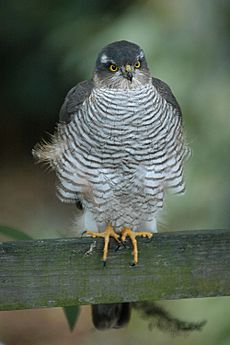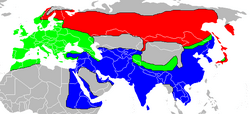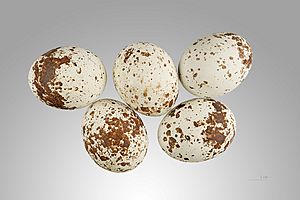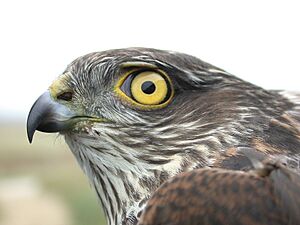Sparrowhawk facts for kids
Quick facts for kids Sparrowhawk |
|
|---|---|
 |
|
| A female Eurasian sparrowhawk | |
| Conservation status | |
| Scientific classification | |
| Kingdom: | |
| Phylum: | |
| Class: | |
| Order: |
Falconiformes (or Accipitriformes, q.v.)
|
| Family: | |
| Subfamily: | |
| Genus: |
Accipiter
|
| Species: |
A. nisus
|
| Binomial name | |
| Accipiter nisus (Linnaeus, 1758)
|
|
 |
|
|
Breeding summer visitor Resident year-round Non-breeding winter visitor
|
|
The sparrowhawk (Accipiter nisus) is a small but powerful bird of prey. It belongs to the Accipitridae family, which includes hawks and eagles. You can find sparrowhawks across a wide area, including Eurasia and northern Africa.
Male sparrowhawks have a cool blue-grey back and wings. Their chest and belly are covered in thin orange stripes. Female and young sparrowhawks look a bit different. They have brown backs and wings, with thin brown stripes on their undersides. Females are much larger than males, sometimes up to 25% bigger. This is one of the biggest size differences seen in any bird species!
Sparrowhawks mainly eat small birds that live in woodland areas. However, they are very adaptable. You can often spot them hunting birds in towns and city gardens. Male sparrowhawks usually hunt smaller birds like tits, finches, and sparrows. Females are bigger and can catch larger birds such as thrushes and starlings. They are strong enough to kill birds weighing over 500 grams (about 1.1 pounds).
You can find sparrowhawks in Europe, parts of Asia, and parts of Africa. Birds that breed in the far north will migrate south for the winter. Those living further south either stay put or fly shorter distances.
Contents
What a Sparrowhawk Looks Like
The sparrowhawk is a small bird of prey with short, wide wings and a long tail. These features help it fly quickly and easily through trees.
Size Differences
Female sparrowhawks are much larger than males. They can be up to 25% longer and twice as heavy! This difference in size between males and females is called "reverse sexual dimorphism". It's quite rare in most animals with backbones (vertebrates) but is common in birds of prey.
- A male sparrowhawk is about 29 to 34 centimeters (11 to 13 inches) long.
- His wingspan is about 59 to 64 centimeters (23 to 25 inches).
- He weighs between 110 and 196 grams (3.9 to 6.9 ounces).
- Males have a slate-grey back and wings, sometimes looking more blue.
- Their chest and belly have thin red stripes, which can appear orange.
- Their eyes are orange-yellow or orange-red.
- A female sparrowhawk is much bigger, about 35 to 41 centimeters (14 to 16 inches) long.
- Her wingspan is about 67 to 80 centimeters (26 to 31 inches).
- She weighs between 185 and 342 grams (6.5 to 12.1 ounces).
- Females have dark brown or grey-brown backs and wings.
- They have brown stripes on their chest and belly.
- Their eyes are bright yellow to orange.
Young sparrowhawks have brown backs and wings. The edges of their feathers are often a rusty color. They have larger brown stripes and spots on their chest and belly, and their eyes are usually pale yellow.
Camouflage and Flight
The sparrowhawk's pale underside and darker back are a type of camouflage called "countershading". This coloring helps them blend in by making them less visible when light shines from above. Many animals, including other birds of prey, use countershading. The stripes on a sparrowhawk are typical for birds of prey that live in forests.
Sparrowhawks fly with a "flap-flap-glide" pattern. This means their flight looks like it goes up and down. Sparrowhawks in northern Great Britain have longer wings than those in the south. The sparrowhawk has a small, hooked beak, which it uses to remove feathers from its prey. Its long legs and toes are perfect for catching and holding birds. The middle toe is especially long and helps it grab things tightly.
Life Cycle and Survival
Sparrowhawks build their nests in woodlands. The nest can be up to 60 centimeters (about 2 feet) wide and is made from twigs. The female lays four or five eggs, which have pale blue shells. The chicks hatch after about 33 days. They then stay in the nest for another 24 to 28 days before they are ready to fly.
Most sparrowhawks live for about four years. About 34% of young birds survive to be one year old. For adults, about 69% survive from one year to the next. The oldest known wild sparrowhawk lived for more than 20 years!
Young sparrowhawks weigh less than adults. They are especially light in the first two months after leaving the nest. Many young birds, especially males, may not survive this time. This might be because smaller males catch smaller food. They cannot catch some of the bigger prey that females can. This means they need to eat more often. A female sparrowhawk can survive for about seven days without eating, but a male can only last about four days.
History and Comeback
In the 1950s, the number of sparrowhawks in Europe dropped a lot. This happened because of chemicals called "pesticides" that were used to kill unwanted insects. These pesticides were put on seeds before planting. Small birds ate the seeds, and then sparrowhawks ate the small birds. The amount of chemicals built up in the food chain.
This affected the sparrowhawks in a bad way. Some were poisoned directly. Others laid eggs with shells that were too thin. These thin shells broke before the chicks could hatch.
Luckily, these harmful pesticides were banned. After the ban, the sparrowhawk population started to grow again. Today, it is one of the most common birds of prey in Europe!
Sparrowhawks and People
Because sparrowhawks hunt other birds, some people who own homing pigeons or raise birds for food might not like them. Some people also thought that sparrowhawks were causing the number of smaller birds to decrease.
However, scientists have studied this. They found that more sparrowhawks did not actually reduce the number of birds living on farmland and in woodlands in the 1960s. Research in Scotland also showed that less than 1% of homing pigeons that died were killed by sparrowhawks.
People have used sparrowhawks for falconry (hunting with a bird of prey) for over 500 years. They are known to be difficult to train but very brave hunters. The sparrowhawk also appears in some old German myths. It is even mentioned in a play by William Shakespeare and a poem by Ted Hughes.
Scientific Classification
The sparrowhawk is part of the Accipitridae family and the Accipiter genus. In the past, some people in England called the sparrowhawk the "blue hawk" because of the male's color. Other old names include spar hawk, spur hawk, and stone falcon.
The Swedish biologist Carolus Linnaeus was the first person to describe the sparrowhawk scientifically in 1758. He named it Falco nisus. Later, in 1760, the French naturalist Mathurin Jacques Brisson moved it into the Accipiter genus.
The current scientific name comes from Latin words: accipiter means "hawk," and nisus refers to the sparrowhawk.




